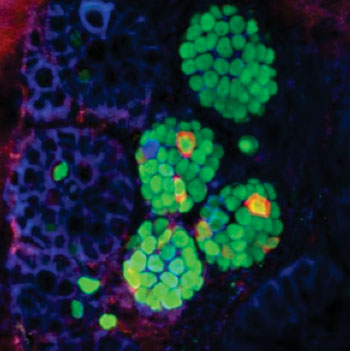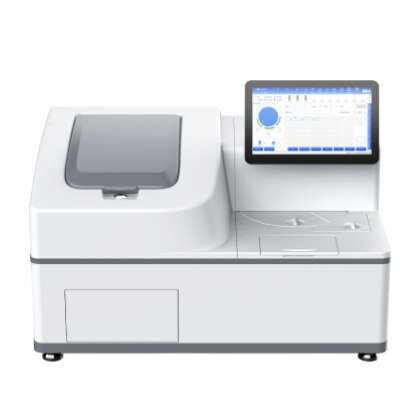Transformed Intestinal Cells Produce Insulin in Novel Diabetes Treatment
By LabMedica International staff writers
Posted on 26 Mar 2014
A population of intestinal cells was found to be capable of morphing into insulin-producing beta-cells, which may pave the way a novel treatment for diabetes.Posted on 26 Mar 2014
Type I diabetes mellitus, also known as insulin dependent diabetes, is believed to be caused by an autoimmune response where the body's own immune system attacks the beta cells and destroys them. The body can no longer produce and secrete insulin into the blood and fails to regulate the blood glucose concentration.

Image: Insulin-expressing cells (red) arising within the intestinal crypts (green) of a mouse that received three beta-cell “reprogramming factors” (Photo courtesy of Dr. Ben Stanger, University of Pennsylvania).
Investigators at the University of Pennsylvania (Philadelphia, USA) had shown previously that introduction of three beta-cell transcription factors—Pdx1 (P), MafA (M), and Ngn3 (N) [collectively called PMN] into the acinar cells of the pancreas could cause these cells to transform into insulin-producing beta-like cells.
In the current study, the investigators sought other readily available cell types that could be transformed into beta-like cells. To this end they performed an in vivo screen by expressing the three beta cell “reprogramming factors” in a wide spectrum of tissues.
They reported in the March 6, 2014, online edition of the journal Cell Reports that in a mouse model the transient expression of PMN in intestinal cells promoted the rapid conversion of intestinal crypt cells into endocrine cells, which coalesced into “neoislets” below the crypt base. Neoislet cells expressed insulin and showed ultrastructural features of beta cells. Importantly, intestinal neoislets were glucose-responsive and able to ameliorate hyperglycemia in diabetic mice. Furthermore, PMN expression in human intestinal “organoids” stimulated the conversion of intestinal epithelial cells into beta-like cells.
“Our results demonstrate that the intestine could be an accessible and abundant source of functional insulin-producing cells,” said senior author Dr. Ben Z. Stanger, assistant professor of medicine at the University of Pennsylvania. “Our ultimate goal is to obtain epithelial cells from diabetes patients who have had endoscopies, expand these cells, add PMN to them to make beta-like cells, and then give them back to the patient as an alternate therapy. There is a long way to go for this to be possible, including improving the functional properties of the cells, so that they more closely resemble beta cells, and figuring out alternate ways of converting intestinal cells to beta-like cells without gene therapy.”
“It is a powerful idea that if you have the right combination of transcription factors you can make any cell into any other cell. It is cellular alchemy,” said Dr. Stanger.
Related Links:
University of Pennsylvania













